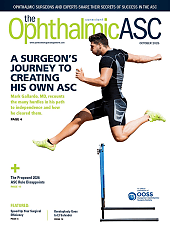In a panel convened by Lumenis at VisionExpo West in September, leading eyecare professionals discussed underrecognized factors that contribute to dry eye, as well as the importance of early detection, advanced technology, and interdisciplinary collaboration in managing dry eye disease. The session, titled “A New Era of Dry Eye Management: A Targeted Approach to a Multifactorial Disease,” featured moderator Cory Lappin, OD, alongside Laura Periman, MD, and Celesta Ferreira, OD.
Dry Eye Contributing Factors
The panelists stressed that dry eye is seldom the result of a single cause and often overlaps with other ocular surface disorders. They identified comprehensive patient histories and diagnostic testing—including meibography, corneal staining, and osmolarity—as essential for isolating the underlying contributors.
They also highlighted lower eyelid laxity as an underrecognized factor in tear film instability and drainage. Citing a 2016 study in Cornea, they said patients with eyelid laxity are more than twice as likely to develop severe ocular surface symptoms and signs of dry eye disease.
According to another Cornea study, they said, meibomian gland dysfunction (MGD) accounts for approximately 86% of all dry eye cases. They discussed device-based treatments to target root causes rather than symptoms alone: OptiLIGHT intense pulsed light (IPL) was described as a key tool for addressing MGD and ocular rosacea. They added that dynamic muscle stimulation is a newer technology that is designed to improve eyelid tone and blinking function.
“Dry eye is so often the ‘and’, not the ‘or’,” said Dr. Lappin in a press release about the panel. “Each contributing factor needs to be identified and addressed to achieve lasting relief.”
Dry Eye as a Specialty
While dry eye has traditionally been associated with older adults, the panelists noted a growing prevalence among younger patients. Dr. Ferreira reported that her clinic now screens nearly every patient, given the earlier and more frequent signs of MGD and lower lid laxity, specifically. “If their face fits in my meibographer, they’re getting scanned,” she said in the press release. She noted that clinicians may miss up to 50% of cases if they are screening only those with symptoms.
The panelists encouraged practices to treat dry eye as a dedicated specialty rather than a secondary service. They noted that device-based procedures such as IPL enable longer, higher-value patient interactions while maintaining financial sustainability. “You can see fewer patients, spend more time with them, and still make it work financially—you don’t have to stay on the hamster wheel,” Dr. Lappin said in the press release. The panelists also noted that incorporating advanced technologies can attract new associates who are seeking to provide comprehensive, device-based care.
For practices in which time constraints are a concern, Dr. Periman advised starting small by dedicating a block of time per week to dry eye care. “Start with a half-day clinic. Slow it down, do dry eye, and you’ll be shocked at how fast it grows,” she said.
Complementing Technology With Collaboration
Looking to the next 5 years, the panelists expressed optimism about technologies that allow for individualized treatment for inflammation, lower lid laxity, blinking dysfunction, and more to improve both outcomes and patient quality of life. They also discussed the importance of cross-specialty collaboration: in the press release, Dr. Ferreira said, “Every systemic condition can have a link to dry eye. The body works as a unit, and if we don’t understand that we all need to work together, we’re going to miss the boat on a ton of dry eye.”
Dr. Lappin added that newer therapies are moving beyond symptomatic relief. “We had band-aids, but now we’re starting to drill down into what’s really driving disease,” he said.








